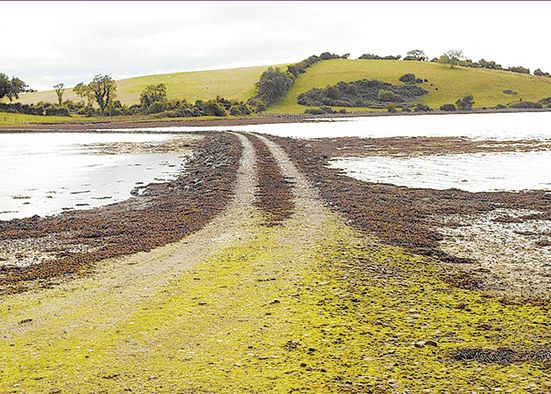The Ghost of Gore’s Island.... a short story
The Ghost of Gore’s Island.... a short story
18 June 2025

LOCATED in picturesque Strangford Lough lies Gore’s Island. The lough is scattered with over 120 islands – some no bigger than a milk float, others sizeable enough to host both people and wildlife.
Gore’s Island is accessible via a tidal causeway, which offers any curious
visitor a risky adventure. Crossing must be timed with care before the sea reclaims the land beneath its salted cloak.
This fable came to me twice over the years, both times by word of mouth. Each telling came with its own twist, as is often the way with stories passed along by lips and memory.
The island almost appears to be two land masses as you approach – its strange, contorted shape caused by nature’s hand.
The northern shore is more exposed, battered by the lough’s unpredictable moods. I’ve explored the island many times, enough to gain a working sense of its layout. Small, ragged fields line the land, bordered with hawthorn and tangled with ragweed.
On my second expedition, I stumbled upon a ruined red-brick building smothered by ash trees and nettles. As one might date a tree by its rings, I tried to read the story of the house – a single-story red-brick structure, its face fractured and weeping rust from broken metal window frames. It must have stood for over 70 years, long-abandoned. My assumptions, it turned out, weren’t far from the truth.
I began researching the island’s history like a hound on a scent. I learned that sometime in the 1940s, Gore’s Island had been used as a summer retreat for youths from the greater Belfast and Bangor area. The programme, it seems, ran until the mid-1960s, after which any mention of the island’s use disappears into the mist of time.
Now, to the story itself. It’s hard to say when it first came to be, but I imagine the events unfolded in the 1970s or 80s.
Martin lived with his wife, Eleanor, and their daughter, Katie, less than half a mile from Gore’s Island. At 53, Martin was looking forward to a simpler life – one free of his job driving for the Education Board.
Not that he was ungrateful, but the creeping weight of age had begun to dull his spirit.
Eleanor worked as a classroom assistant at the local school. Time seemed to leave her untouched. Martin found grounding in his relationship with Katie, and their walks along the country roads and the shoreline of Strangford Lough were precious to him.
“No matter the coin in your pocket,” Martin would tell Katie, “all God’s country belongs to everyone.” Their walks were filled with stories – tales of ancient chieftains, of Strongbow, of myth and memory.
Gore’s Island was a recurring
destination that served two purposes – to exercise both body and mind, and to gather mussels to enrich the evening’s pot.
On a cool September afternoon, the tide was retreating. Martin and Katie agreed to take opposite sides of the island and meet back at the causeway in an hour.
Katie went left and Martin right, each heading toward the northern point before circling back. Katie, armed with a brown cloth mesh sack, picked mussels along the shore. Upon reaching the northern headland, she rested in the shade of an ash tree, surveying her bounty.
When she finally made her way back to the causeway, she sat on a large, barnacle-free rock to wait. The sun climbed high and time dragged on. Eventually, Katie saw a figure approaching from the island. She called out, expecting her father’s wave, but the figure offered no response.
Moments later, she saw something stranger still – her father, apparently stopped mid-path, talking to another man. This puzzled her. Martin was friendly, but never one to linger in idle chat with strangers.
Frustrated, Katie shouted again, louder this time. Finally, Martin began to approach.
When he reached her, she scolded him for leaving her waiting and wasting time with a stranger. But Martin’s expression turned grave, confused even. According to him, he hadn’t spoken to anyone. He had walked the shoreline alone, stopping only to pry mussels from the rocks.
And then, with a puzzled tone, he added something that sent a chill through Katie.
“I only stopped when I saw you... standing with someone on the causeway.”


